Experimental Investigation on the Mechanical Characteristics of a Novel Hybrid Densified Wood-Filled Aluminum Tube Dowel for Timber Connections †
Abstract
:1. Introduction
2. Experimental
2.1. Materials
2.2. Manufacturing of the Hybrid Dowels
2.3. Three-Point Bending Test Dowels
2.4. Slotted-In Aluminum Plate Timber Connection Tests
2.5. Push-Out Shear Tests on Timber-to-Timber Connections
3. Results and Discussion
3.1. Three-Point Bending Tests
3.2. Push-Out Shear Tests
3.3. Slotted-In Aluminum Plate Timber Connection Tests
4. Conclusions
- (1)
- Three-point bending on both densified wood (DW) dowels and densified wood-filled aluminum tube (DWFAT) dowels;
- (2)
- Push-out double shear timber-to-timber connections assembled either using DW dowels or DWFAT dowels;
- (3)
- Slotted-in aluminum plate timber connections assembled using either steel dowels or DWFAT dowels;
Author Contributions
Funding
Institutional Review Board Statement
Informed Consent Statement
Data Availability Statement
Acknowledgments
Conflicts of Interest
References
- Santos, C.L.; de Jesus, A.M.P.; Morais, J.J.L.; Fontoura, B.F.C. An experimental comparison of strengthening solutions for dowel-type wood connections. Constr. Build. Mater. 2013, 46, 114–127. [Google Scholar] [CrossRef]
- Meghlat, E.-M.; Oudjene, M.; Ait-Aider, H.; Batoz, J.-L. A new approach to model nailed and screwed timber joints using the finite element method. Constr. Build. Mater. 2013, 41, 263–269. [Google Scholar] [CrossRef]
- Oudjene, M.; Khelifa, M. Experimental and numerical analyses of single double shear dowel-type timber joints. In Proceedings of the 11th World Conference on Timber Engineering, Trentino, Italy, 20–24 June 2010. [Google Scholar]
- Guan, Z.-W.; Rodd, P.D. Hollow steel dowels—A new application in semi-rigid timber connections. Eng. Struct. 2001, 23, 110–119. [Google Scholar] [CrossRef]
- Zarnani, P.; Quenneville, P. Strength of timber connections under potential failure modes: An improved design procedure. Constr. Build. Mater. 2014, 60, 81–90. [Google Scholar] [CrossRef]
- Branco, J.M.; Cruz, P.J.S.; Piazza, M. Experimental analysis of laterally loaded nailed timber-to-concrete connections. Constr. Build. Mater. 2009, 23, 400–410. [Google Scholar] [CrossRef]
- Caldeira, T.V.P.; Dourado, N.; de Jesus, A.M.P.; de Moura, M.F.S.F.; Morais, J.J.L. Quasi-static behavior of moment-carrying steel–wood doweled joints. Constr. Build. Mater. 2014, 53, 439–447. [Google Scholar] [CrossRef]
- Karagiannis, V.; Málaga-Chuquitaype, C.; Elghazouli, A.Y. Modified foundation modelling of dowel embedment in glulam connections. Constr. Build. Mater. 2016, 102 Pt 2, 1168–1179. [Google Scholar] [CrossRef]
- Jorissen, A.; Fragiacomo, M. General notes on ductility in timber structures. Eng. Struct. 2011, 33, 2987–2997. [Google Scholar] [CrossRef]
- Gavric, I.; Fragiacomo, M. Cyclic behaviour of typical metal connectors for cross-laminated (CLT) structures. Mater. Struct. 2015, 48, 1841–1857. [Google Scholar] [CrossRef]
- Lokaj, A.; Klajmonova, K. Dowel type joints of round timber exposed to static and cyclic tension forces. Procedia Eng. 2015, 114, 240–247. [Google Scholar] [CrossRef]
- Wei, Y.L.; Quenneville, P.; Nawawi, C. A numerical study of the seismic behaviour of timber shear walls with slip-friction connectors. Eng. Struct. 2012, 34, 233–243. [Google Scholar]
- Smith, I.; Whale, L.R.J.; Anderson, C.; Hilson, B.O.; Rodd, P.D. Design properties of laterally loaded nailed or bolted joints. Can. J. Civ. Eng. 1998, 15, 633–643. [Google Scholar] [CrossRef]
- Toumpanaki, E.; Ramage, M.H. Glued-in CFRP and GFRP rods in block laminated timber subjected to monotonic and cyclic loading. Compos. Struct. 2021, 272, 114201. [Google Scholar]
- Khelifa, M.; Oudjene, M.; Ben Elechi, S.; Rahim, M. FE stress analysis and prediction of the pull-out of FRP rods glued into glulam timber. Wood Mater. Sci. Eng. 2022, 17, 53–62. [Google Scholar] [CrossRef]
- O’Loinsigh, C.; Oudjene, M.; Shotton, E.; Pizzi, A.; Fanning, P. Mechanical Behaviour and 3D Stress Analysis of Multi-Layered Wooden Beams Made with Welded-throughWood Dowels. Compos. Struct. 2012, 94, 313–321. [Google Scholar] [CrossRef]
- O’Loinsigh, C.; Oudjene, M.; Ait-Aider, H.; Fanning, P.; Pizzi, A.; Shotton, E.; Meghlat, E.M. Experimental Study of Timber-to-Timber Composite Beam Using Welded-throughWood Dowels. Constr. Build. Mater. 2012, 36, 245–250. [Google Scholar] [CrossRef]
- Thomson, A. The Structural Performance of Nonmetallic Timber Connections. Ph.D. Thesis, University of Bath, Bath, UK, 2010. [Google Scholar]
- Thomson, A.; Harris, R.; Ansell, M.; Walker, P. Experimental performance of non-metallic mechanically fastened timber connections. Struct. Eng. 2010, 88, 25–32. [Google Scholar]
- Thomson, A.; Harris, R.; Walker, P.; Ansell, M. Development of non-metallic timber connections for contemporary applications. In Proceedings of the 11th World Conference on Timber Engineering (WCTE2010), Trentino, Italy, 20–24 June 2010. [Google Scholar]
- Palma, P.; Kobel, P.; Minor, A.; Frangi, A. Dowelled timber connections with internal members of densified veneer wood and fibre-reinforced polymer dowels. In Proceedings of the World Conference on Timber Engineering (WCTE), Vienna, Austria, 22–25 August 2016. [Google Scholar]
- Mehra, S.; O’Ceallaigh, C.; Sotayo, A.; Guan, Z.; Harte, A.-M. Experimental investigation of the moment-rotation behaviour of beam-column connections produced using compressed wood connectors. Constr. Build. Mater. 2022, 333, 127327. [Google Scholar] [CrossRef]
- El-Houjeyri, I.; Thi, V.-D.; Oudjene, M.; Khelifa, M.; Rogaume, Y.; Sotayo, A.; Guan, Z. Experimental investigations on adhesive free laminated oak timber beams and timber-to-timber joints assembled using thermo-mechanically compressed wood dowels. Constr. Build. Mater. 2019, 222, 288–299. [Google Scholar]
- El-Houjeyri, I.; Thi, V.-D.; Oudjene, M.; Ottenhaus, L.-M.; Khelifa, M.; Rogaume, Y. Coupled nonlinear-damage finite element analysis and design of novel engineered wood products made of oak hardwood. Eur. J. Wood Wood Prod. 2021, 79, 29–47. [Google Scholar]
- Han, L.; Kutnar, A.; Sandak, J.; Šušteršič, I.; Sandberg, D. Adhesive-and Metal-Free Assembly Techniques for Prefabricated Multi-Layer Engineered Wood Products: A Review on Wooden Connectors. Forests 2023, 14, 311. [Google Scholar] [CrossRef]
- Namari, S.; Drosky, L.; Pudlitz, B.; Haller, P.; Sotayo, A.; Bradley, D.; Mehra, S.; O’Ceallaigh, C.; Harte, A.-M.; El-Houjeyri, I.; et al. Mechanical properties of compressed wood. Constr. Build. Mater. 2021, 301, 124269. [Google Scholar]
- Gouvernement du Québec. Ministère des Forêts, de la Faune et des Parcs (MFFP), “Charte du bois”; Gouvernement du Québec: Montréal, QC, Canada, 2013.
- Gouvernement du Québec. Ministère de l’Économie, de la Science et de l’Innovation. Stratégie Québécoise de Développement de L’aluminium 2015–2025; Gouvernement du Québec: Montréal, QC, Canada, 2015.
- Beudon, C.; Oudjene, M.; Djedid, A.; Annan, C.-D.; Fafard, M. Life Cycle Assessment of an Innovative Hybrid Highway Bridge Made of an Aluminum Deck and Glulam Timber Beams. Buildings 2022, 12, 1616. [Google Scholar] [CrossRef]
- Vesenjak, M.; Duarte, I.; Baumeister, J.; Göhler, H.; Krstulović-Opara, L.; Ren, Z. Bending performance evaluation of aluminium alloy tubes filled with different cellular metal cores. Compos. Struct. 2020, 234, 111748. [Google Scholar] [CrossRef]
- Kampour, H.; Bourges, M.; Gilbert, B.P.; Bismire, A.; Bailleres, H. Compressive behaviour of novel timber-filled steel tubular (TFST) columns. Constr. Build. Mater. 2020, 238, 117734. [Google Scholar] [CrossRef]
- Wouts, J.; Haugou, G.; Oudjene, M.; Naceur, H.; Coutellier, D. Confinement device to assess dynamic crushability of wood material. J. Mech. Eng. Sci. 2018, 232, 1418–1432. [Google Scholar] [CrossRef]
- Wouts, J.; Haugou, G.; Oudjene, M.; Morvan, H.; Coutellier, D. Strain rate effects on the compressive response of wood and energy absorption capabilities—Part B: Experimental investigation under rigid lateral confinement. Compos. Struct. 2018, 204, 95–104. [Google Scholar]
- Neumann, M.; Herter, J.; Droste, B.O.; Hartwig, S. Compressive behaviour of axially loaded spruce wood under large deformations at different strain rates. Eur. J. Wood Wood Prod. 2011, 69, 345–357. [Google Scholar] [CrossRef]
- Lardeur, P.; Scigliano, R.; Scionti, M. Verification and validation for the vibration study of automotive structures modelled by finite elements. J. Strain. Anal. Eng. Des. 2013, 48, 59–72. [Google Scholar] [CrossRef]
- Bui, T.A.; Lardeur, P.; Oudjene, M.; Park, J. Numerical modelling of the variability of the vibration frequencies of multi-layered timber structures using the modal stability procedure. Compos. Struct. 2022, 285, 115226. [Google Scholar]
- Oudjene, M.; Meghlat, E.M.; Ait-Aider, H.; Lardeur, P.; Khelifa, M.; Batoz, J.-L. Finite element modelling of the nonlinear load-slip behaviour of full-scale timber-to-concrete composite T-shaped beams. Compos. Struct. 2018, 196, 117–126. [Google Scholar]
- CSA O86-14; Canadian Standard Association. Engineering Design in Wood. Canadian Council of Wood: Ottawa, ON, Canada, 2019.
- CSA S157/S157.1; Canadian Standard Association. Strength Design in Aluminum/Commentary on CSA S157-17, Strength design in Aluminum. CSA Group: Ottawa, ON, Canada, 2022.
- EN 26891:1991; Timber Structures–Joints Made with Mechanical Fasteners–General Principles for the Determination of Strength and Deformation Characteristics, ISO 6891–1983 (E). European Committee for Standardization (CEN): Brussels, Belgium, 1991.
- NF EN 12512/A1 (2006-01-01); Structures en Bois–Méthodes D’essai–Essais Cycliques D’assemblages Réalisés par Organes Mécaniques. European Committee for Standardization (CEN): Brussels, Belgium, 2006.


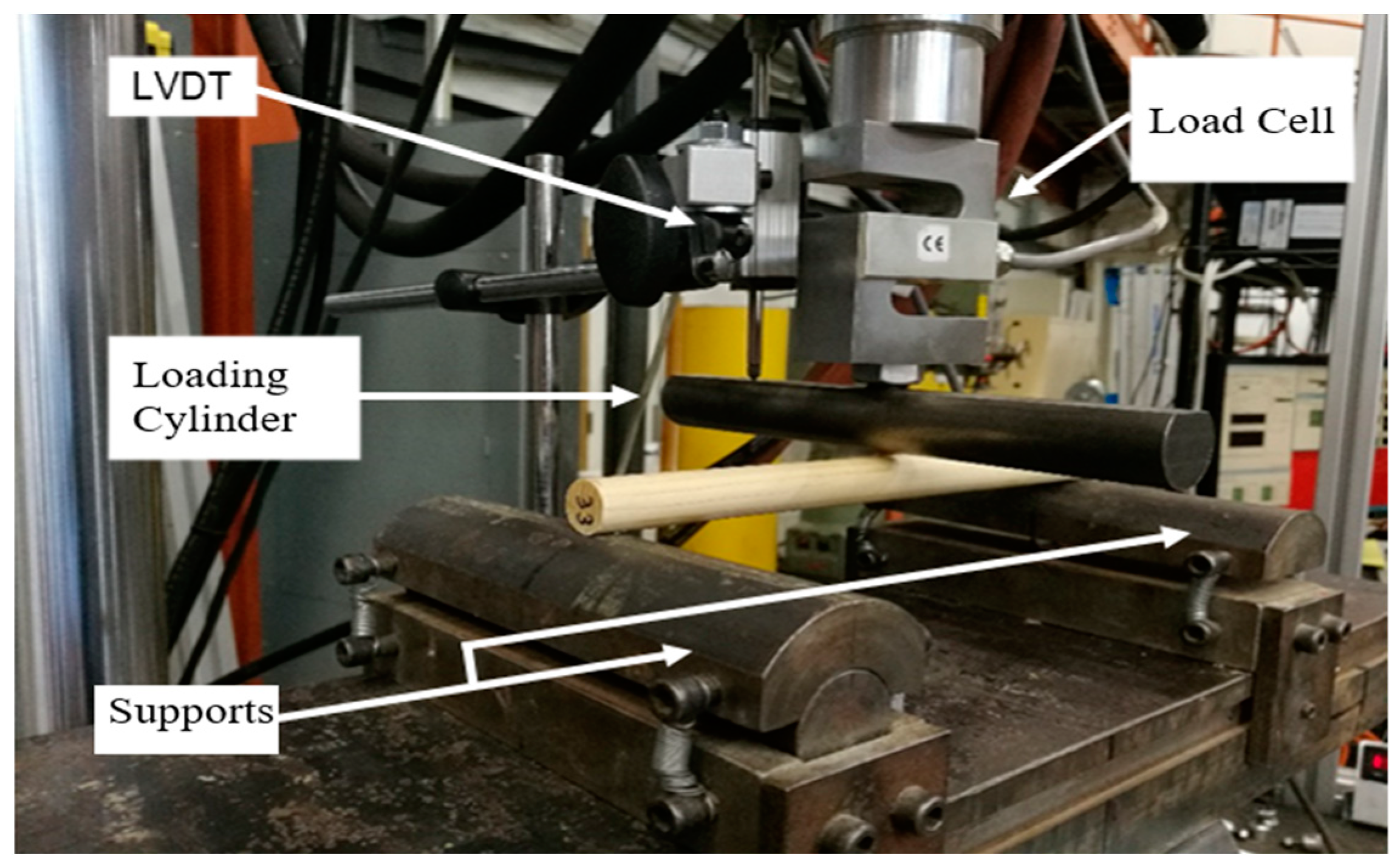

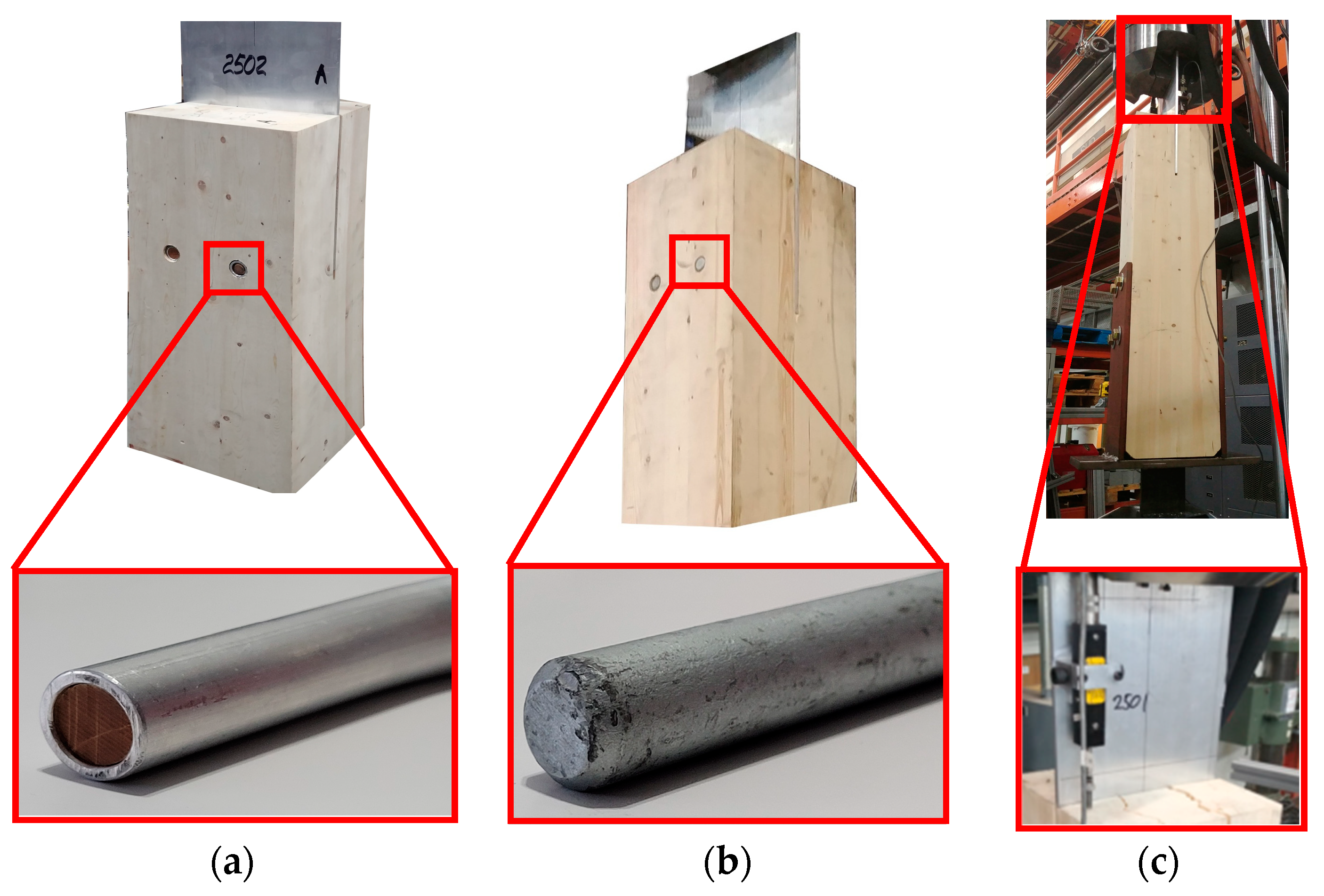

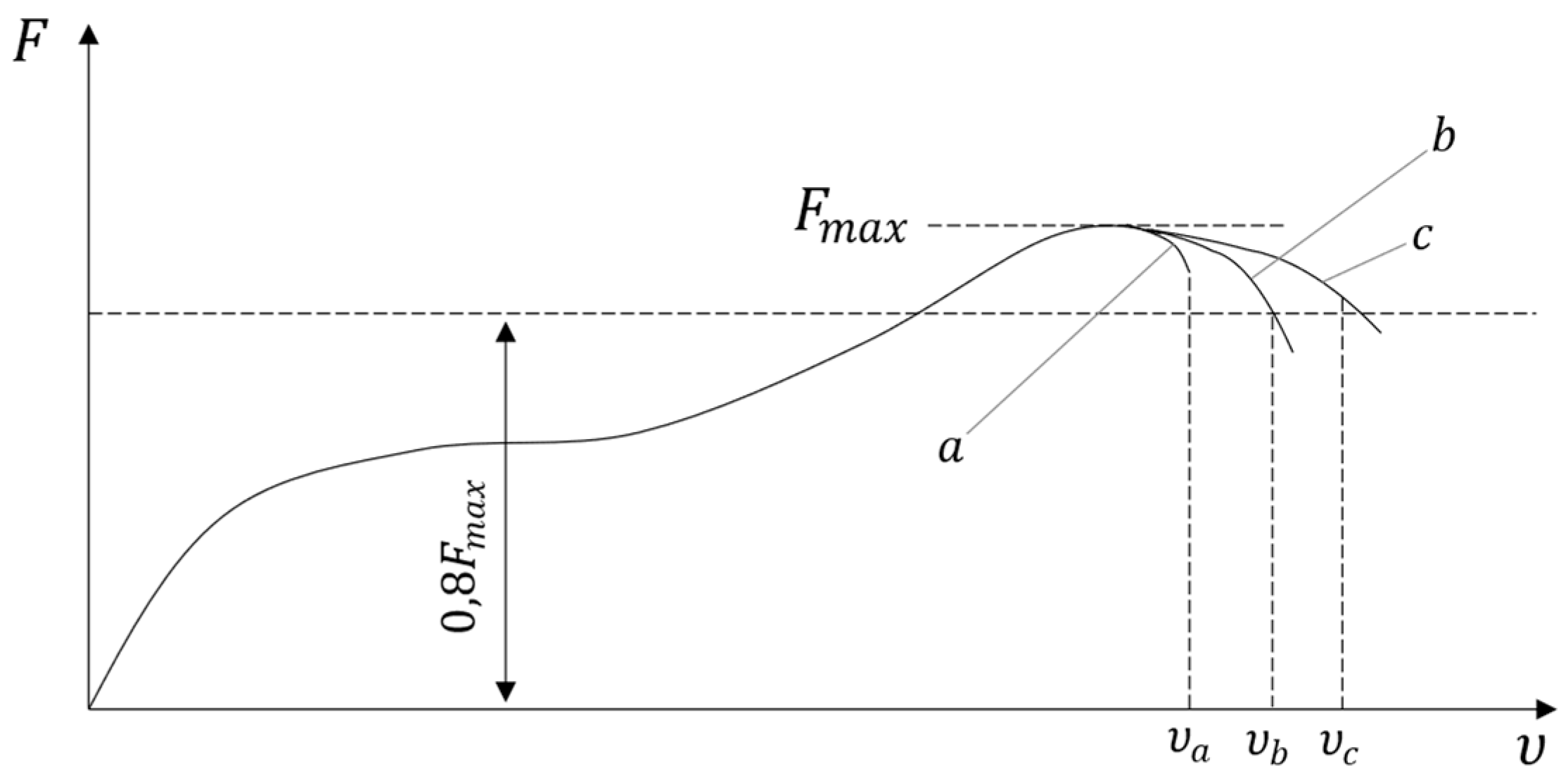

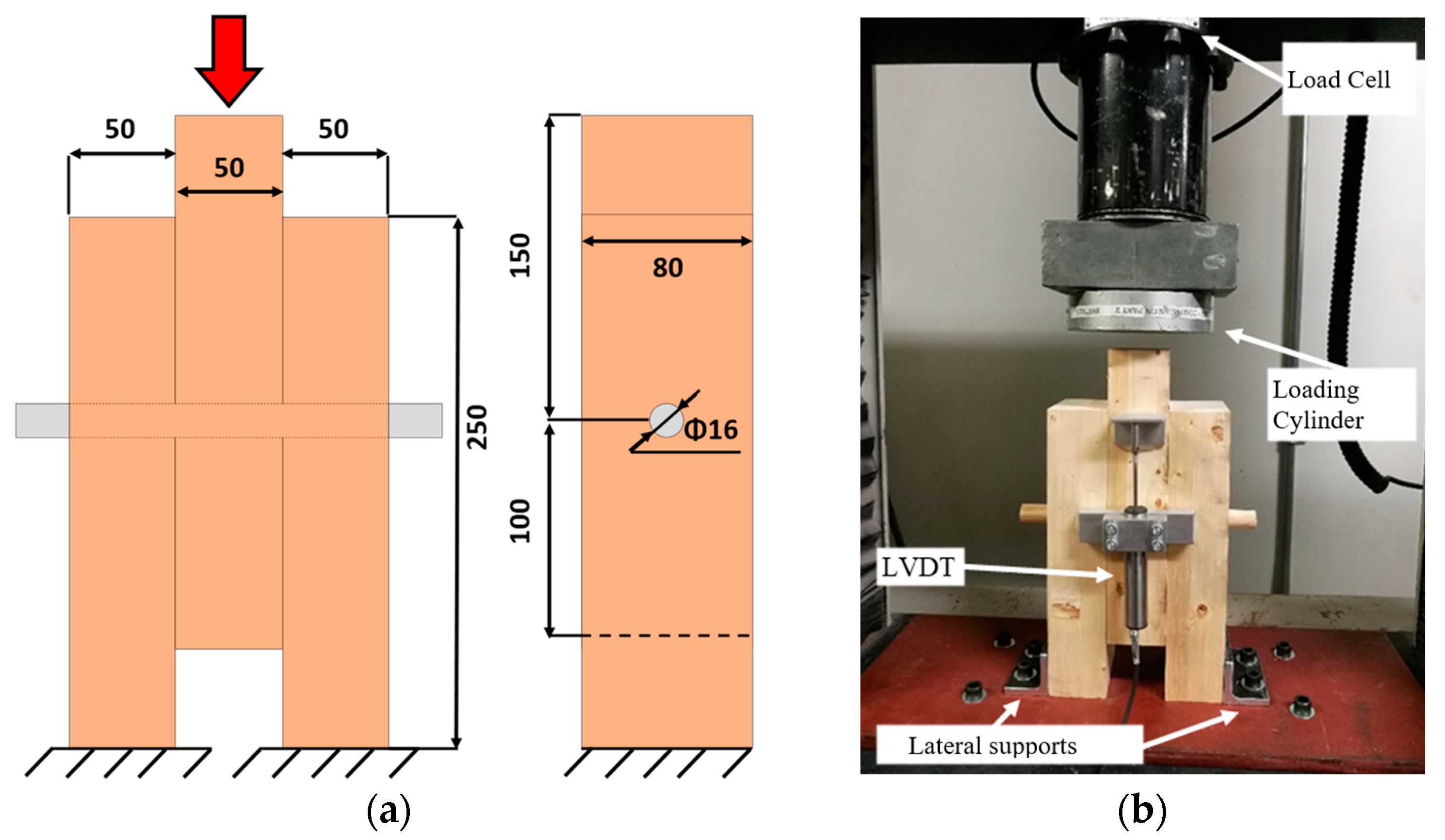
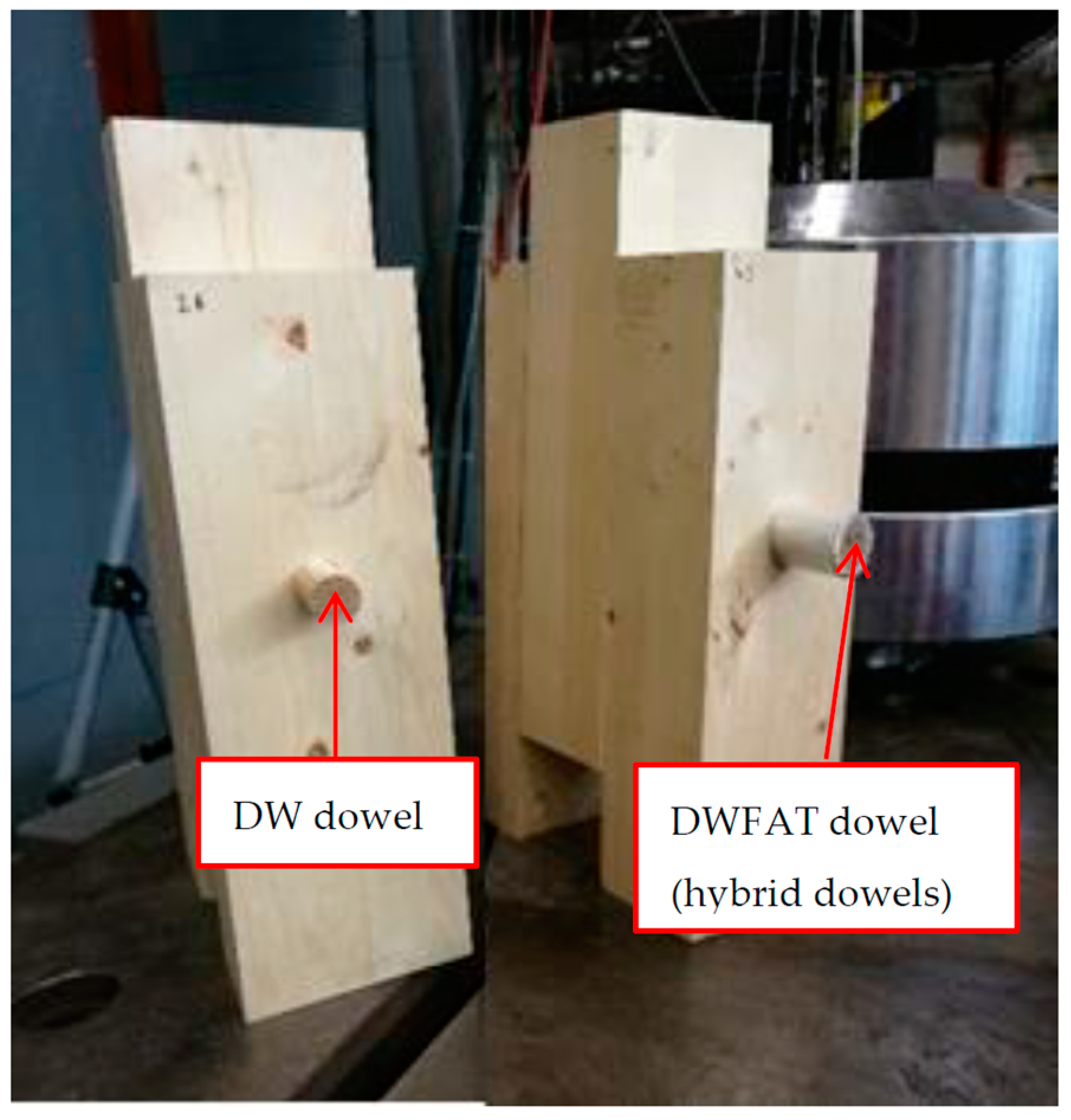

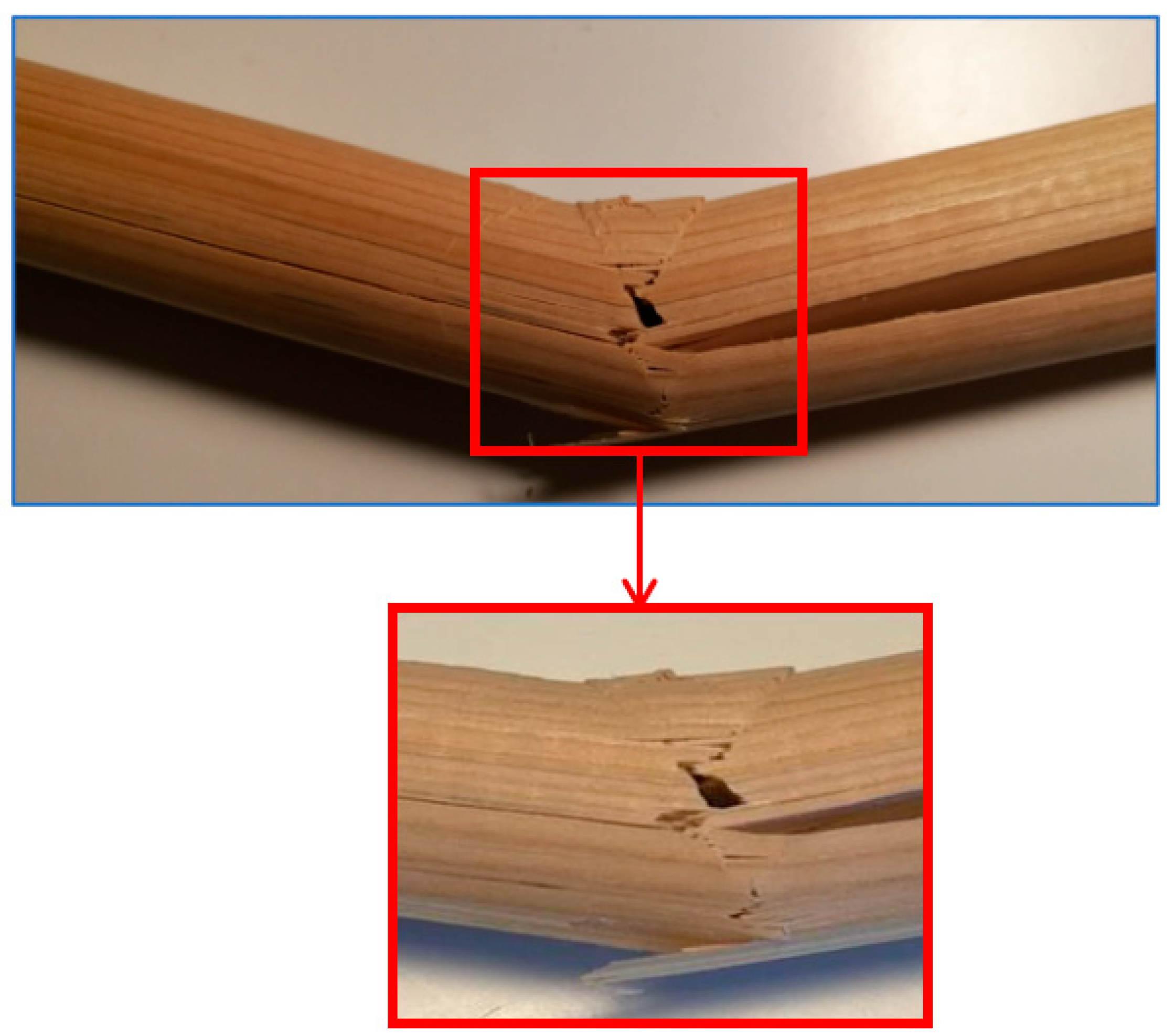

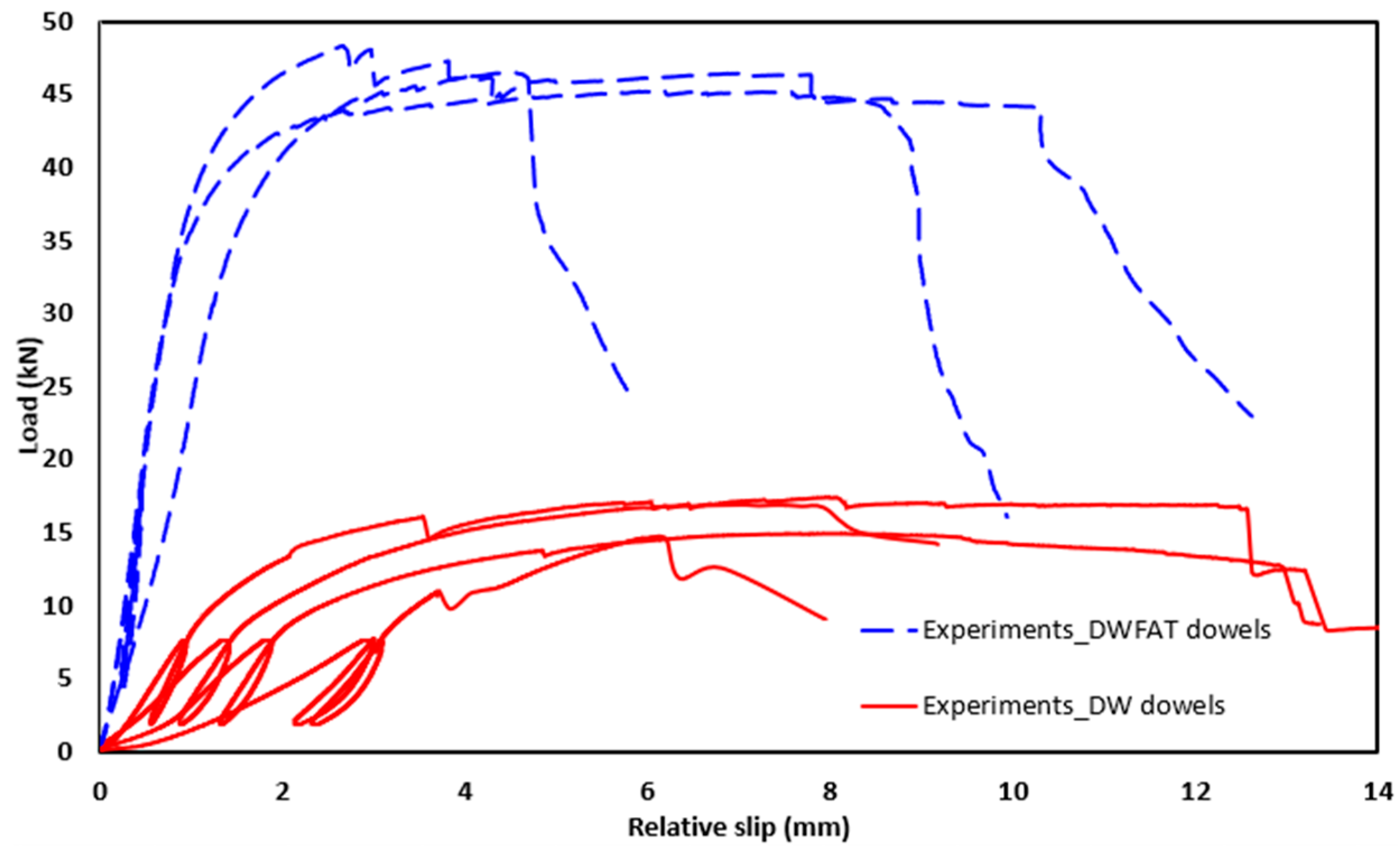
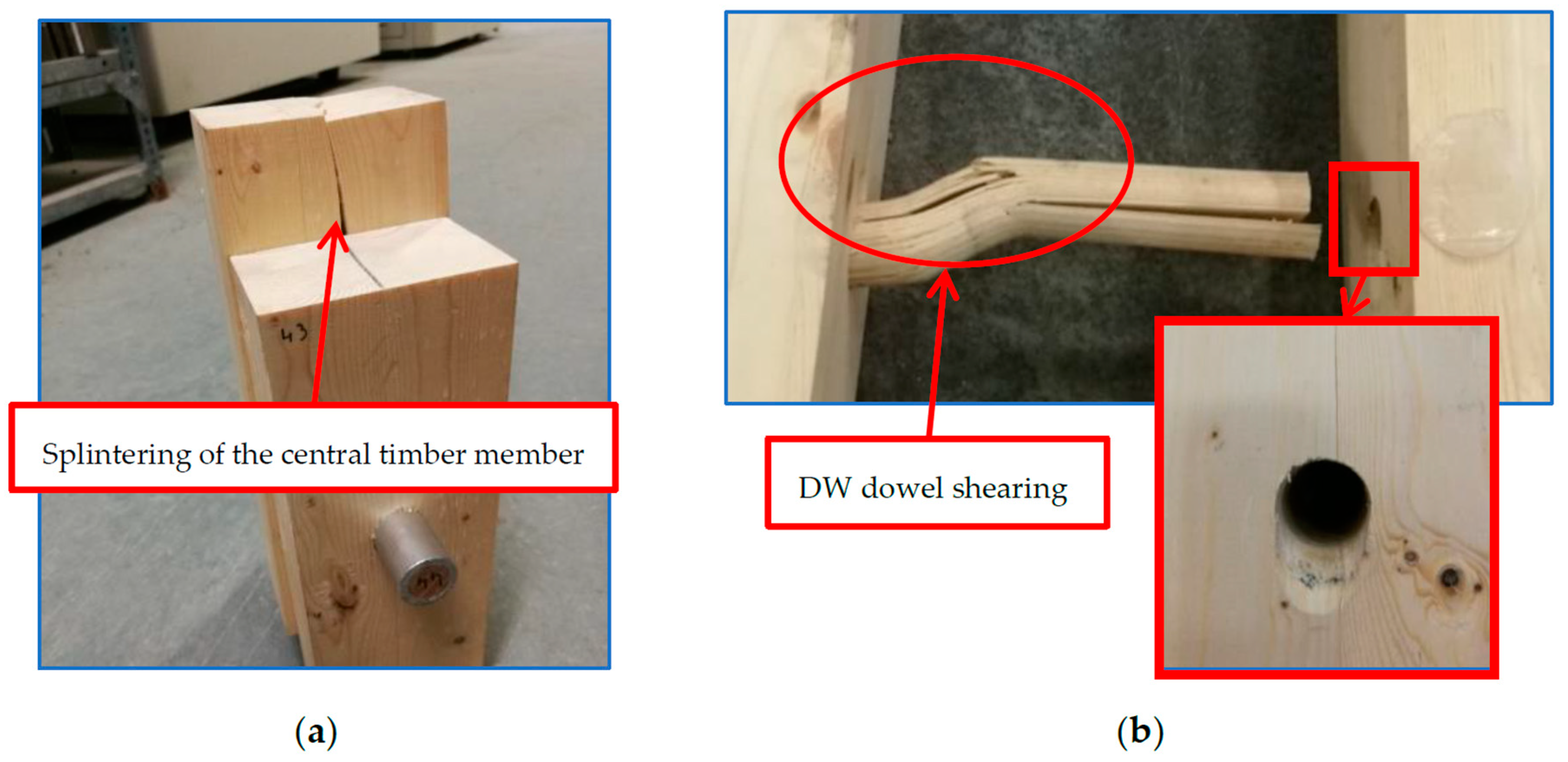


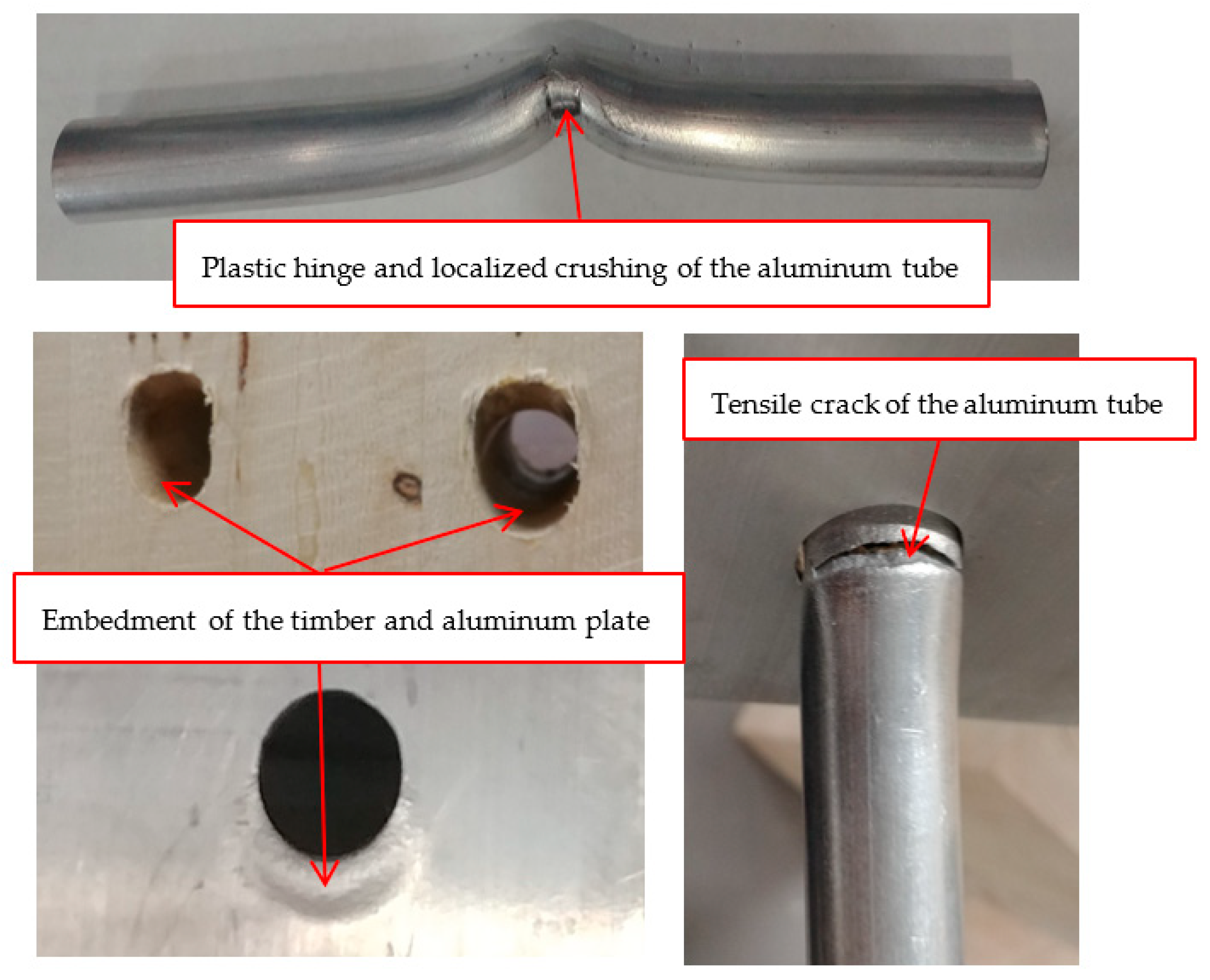
| Fmax (kN) | Kser (kN/mm) | Du | |
|---|---|---|---|
| Test 1 * | 15.0 | 5.4 | 6.2 |
| Test 2 | 16.9 | 5.8 | 5.3 |
| Test 3 | 17.4 | 9.4 | 10.4 |
| Test 4 | 14.8 | 3.3 | 2.2 |
| Test 5 | 19.0 | 2.8 | 4.7 |
| Mean | 16.0 | 6.0 | 5.9 |
| C.o.V.(%) | 1.4 | 2.5 | 3.5 |
| Fmax (kN) | Kser (kN/mm) | Du | |
|---|---|---|---|
| Test 1 * | 46.4 | 22.5 | 8.7 |
| Test 2 | 39.5 | 28.7 | 3.1 |
| Test 3 | 48.3 | 45.0 | 6.7 |
| Test 4 | 45.2 | 45.1 | 15.7 |
| Mean | 44.4 | 39.6 | 8.5 |
| C.o.V. (%) | 4.5 | 9.4 | 6.5 |
| Fmax (kN) | Fy (kN) | Kser (kN/mm) | Du | |
|---|---|---|---|---|
| Test 1 * | 168.9 | 98.9 | / | / |
| Test 2 | 183.4 | 76.9 | 79.9 | 18.8 |
| Test 3 | 193.0 | 78.0 | 85.7 | 23.4 |
| Test 4 | 182.3 | 79.2 | 76.1 | 21.7 |
| Test 5 | 168.6 | 78.0 | 74.1 | 22.0 |
| Mean | 181.8 | 78.1 | 78.9 | 21.5 |
| C.o.V.(%) | 4.8 | 1.1 | 5.6 | 7.8 |
| Fmax (kN) | Fy (kN) | Kser (kN/mm) | Du | |
|---|---|---|---|---|
| Test 1 * | 128.0 | 82.4 | / | / |
| Test 2 | 133.5 | 61.6 | 33.0 | 7.2 |
| Test 3 | 139.5 | 61.0 | 23.1 | 6.4 |
| Test 4 | 128.7 | 60.7 | 46.4 | 11.2 |
| Test 5 | 142.5 | 58.4 | 42.5 | 11.4 |
| Mean | 136.0 | 60.4 | 36.3 | 9.1 |
| C.o.V.(%) | 4.0 | 2.0 | 25.0 | 26.0 |
Disclaimer/Publisher’s Note: The statements, opinions and data contained in all publications are solely those of the individual author(s) and contributor(s) and not of MDPI and/or the editor(s). MDPI and/or the editor(s) disclaim responsibility for any injury to people or property resulting from any ideas, methods, instructions or products referred to in the content. |
© 2023 by the authors. Licensee MDPI, Basel, Switzerland. This article is an open access article distributed under the terms and conditions of the Creative Commons Attribution (CC BY) license (https://creativecommons.org/licenses/by/4.0/).
Share and Cite
Tétreault, M.-G.; Rollo, G.; Oudjene, M.; Fafard, M. Experimental Investigation on the Mechanical Characteristics of a Novel Hybrid Densified Wood-Filled Aluminum Tube Dowel for Timber Connections. Eng. Proc. 2023, 43, 44. https://doi.org/10.3390/engproc2023043044
Tétreault M-G, Rollo G, Oudjene M, Fafard M. Experimental Investigation on the Mechanical Characteristics of a Novel Hybrid Densified Wood-Filled Aluminum Tube Dowel for Timber Connections. Engineering Proceedings. 2023; 43(1):44. https://doi.org/10.3390/engproc2023043044
Chicago/Turabian StyleTétreault, Marie-Gabrielle, Guillaume Rollo, Marc Oudjene, and Mario Fafard. 2023. "Experimental Investigation on the Mechanical Characteristics of a Novel Hybrid Densified Wood-Filled Aluminum Tube Dowel for Timber Connections" Engineering Proceedings 43, no. 1: 44. https://doi.org/10.3390/engproc2023043044
APA StyleTétreault, M.-G., Rollo, G., Oudjene, M., & Fafard, M. (2023). Experimental Investigation on the Mechanical Characteristics of a Novel Hybrid Densified Wood-Filled Aluminum Tube Dowel for Timber Connections. Engineering Proceedings, 43(1), 44. https://doi.org/10.3390/engproc2023043044






